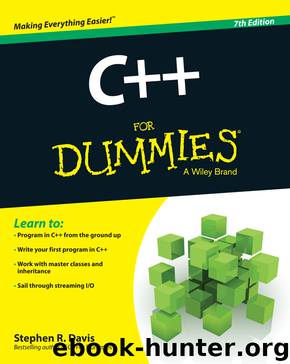C++ For Dummies by Davis Stephen R

Author:Davis , Stephen R.
Language: eng
Format: epub
ISBN: 9781118823835
Publisher: Wiley
Published: 2014-05-16T13:53:39+00:00
Making an Argument for Using Protected Members
Now that you know a little more about how to use protected members in an actual class, I can replay the arguments for using protected members.
Protecting the internal state of the class
Making the gpa member protected precludes the application from setting the grade point average to some arbitrary value. The application can add courses, but it can’t change the grade point average directly.
If the application has a legitimate need to set the grade point average directly, the class can provide a member function for that purpose, as follows:
class Student
{
public:
// same as before
double grade() { return gpa; }
// here we allow the grade to be changed
double grade(double newGPA)
{
double oldGPA = gpa;
// only if the new value is valid
if (newGPA > 0 && newGPA <= 4.0)
{
gpa = newGPA;
}
return oldGPA;
}
// ...other stuff is the same including the data members:
protected:
int semesterHours; // hours earned toward graduation
double gpa;
};
The addition of the member function grade(double) allows the application to set the gpa. Notice, however, that the class still hasn’t given up control completely. The application can’t set gpa to any old value; only a gpa in the legal range of values (from 0 through 4.0) is accepted.
Thus, the Student class has provided access to an internal data member without abdicating its responsibility to make sure that the internal state of the class is valid.
Download
This site does not store any files on its server. We only index and link to content provided by other sites. Please contact the content providers to delete copyright contents if any and email us, we'll remove relevant links or contents immediately.
The Mikado Method by Ola Ellnestam Daniel Brolund(20604)
Hello! Python by Anthony Briggs(19900)
Secrets of the JavaScript Ninja by John Resig Bear Bibeault(18208)
The Well-Grounded Java Developer by Benjamin J. Evans Martijn Verburg(17576)
OCA Java SE 8 Programmer I Certification Guide by Mala Gupta(17422)
Kotlin in Action by Dmitry Jemerov(17185)
Algorithms of the Intelligent Web by Haralambos Marmanis;Dmitry Babenko(16237)
Grails in Action by Glen Smith Peter Ledbrook(15390)
Sass and Compass in Action by Wynn Netherland Nathan Weizenbaum Chris Eppstein Brandon Mathis(13266)
Test-Driven iOS Development with Swift 4 by Dominik Hauser(10394)
Windows APT Warfare by Sheng-Hao Ma(7833)
Layered Design for Ruby on Rails Applications by Vladimir Dementyev(7549)
Blueprints Visual Scripting for Unreal Engine 5 - Third Edition by Marcos Romero & Brenden Sewell(7450)
Solidity Programming Essentials by Ritesh Modi(4568)
Functional Programming in JavaScript by Mantyla Dan(4438)
Hands-On Full-Stack Web Development with GraphQL and React by Sebastian Grebe(4431)
WordPress Plugin Development Cookbook by Yannick Lefebvre(4386)
Unity 3D Game Development by Anthony Davis & Travis Baptiste & Russell Craig & Ryan Stunkel(4270)
The Ultimate iOS Interview Playbook by Avi Tsadok(4252)
